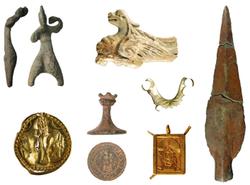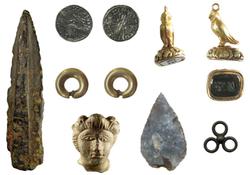Portable Antiquities Scheme
What we doThe Portable Antiquities Scheme (PAS) is a voluntary recording scheme for archaeological objects found by members of the public.
Every year thousands of objects are discovered, many by metal detector users, but also by people whilst out walking, gardening or going about their daily work. Such discoveries offer an important source for understanding our past.
The Treasure Act
All finders of gold and silver objects, and groups of coins from the same finds over 300 years old, have a legal obligation to report such items under the Treasure Act 1996. Now prehistoric base-metal assemblages found after 1 January 2003 also qualify as treasure. Your local Finds Liaison Officer is happy to help you deal with the paperwork and explain the treasure process to you.
Find out more about the Treasure Act on the Portable Antiquities Scheme website.

General Finds Enquiries
For general finds identification enquiries please email us at: PASTeam@birminghammuseums.org.uk
West Midlands Finds Liaison Officers (FLOs)
Victoria Allnatt, Senior Finds Liaison Officer – Worcestershire and Warwickshire (maternity cover)
Worcestershire County Museum, Hartlebury Castle, Kidderminster, DY11 7XZ
Phone: 07518 530904
Email: Victoria.Allnatt@birminghammuseums.org.uk
Twitter: @FLOMidlands
Instagram: FLOWestMids
Teresa Gilmore, Senior Finds Liaison Officer – Staffordshire and West Midlands
Museum Collection Centre, Birmingham Museums Trust, 25 Dollman St, Birmingham B7 4RQ
Phone: 07766 925351
Email: Teresa.Gilmore@birminghammuseums.org.uk
Twitter: @StaffsWMFLO
Facebook: Staffordshire Finds Liaison Officer
Clara De-Sousa Cunha, Finds Liaison Officer – Herefordshire and Shropshire
Ludlow Library and Museum Resource Centre, 7-9 Parkway, Ludlow, Shropshire, SY8 2PG
Phone: TBC
Email: Clara.DeSousaCunha@birminghammuseums.org.uk
Latest Discoveries and Appeals
The Portable Antiquities Scheme (PAS) is dedicated to recording archaeological finds. While the focus is not on museum acquisition, some extraordinary objects recorded through PAS have been added to public collections through a variety of public funding appeals.
The latest appeal is by the Worcestershire Heritage, Art & Museums Charity, to raise funds to acquire the Worcestershire Conquest Hoard. Find out more about on the Museums of Worcestershire website.
For more information about the Portable Antiquities Scheme visit the Finds website.
Contribute to archaeological research via MicroPASTS
You can assist existing research projects with tasks that need human intelligence, such as the accurate location of artefact findspots or photographed scenes, the identification of subject matter in historic archives, the masking of photos meant for 3D modelling, or the transcription of letters and catalogues. Other tasks might require on-location contributions by members of the public, such as submitting your own photographs of particular archaeological sites or objects. By contributing to a MicroPasts project you will:
- Have a direct impact on research in archaeology, history and heritage
- Help with tasks that computers cannot do
- Develop skills that interest you
- Produce results that will be open and freely usable
Visit MicroPASTS.
